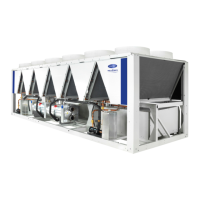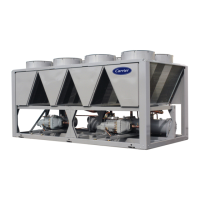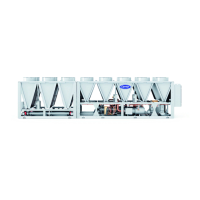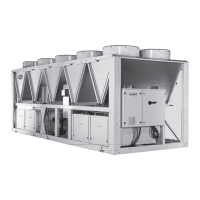51
6 - APPLICATION DATA
6.1 - Operating range
Evaporator Leaving Water Temperature (°C)
Air inlet temperature (°C)
Low brine
Medium brine
Light brine
NOTE
Ranges given as a guide using ethylene glycol for an evaporator ΔT = 3K. Refer
to the electronic catalogue.
Winter operation option (included in standard for 30XBE & 30XBP ranges)
Low temperature brine, (-15°C ethylene glycol / -10°C propylene glycol)
Medium temperature brine, (-12°C ethylene glycol / -8°C propylene glycol)
Light temperature brine, (-3°C ethylene glycol / 0°C propylene glycol)
Full load - 30XB- range
Full load - 30XBE/P ranges
Full load - OPT 15LS(+)
Part load
Power factor correction option (option/QM 231) available for an inlet air
temperature up to +45°C
For operation in pure water at an inlet air temperature below 0°C, the frost
protection (option_41A or 41B) must be provided
ATTENTION: Option 28 (Winter operation)
If the outside temperature is below -10 °C and the unit has
been switched o for more than 4 hours, it is necessary to
wait 2 hours after the unit has been switched on again to allow
the frequency converter to warm up.
Water heat exchanger Minimum Maximum
Entering temperature at start-up °C - 45
(1)
Leaving temperature during operation °C 3,3 15
Entering/leaving water temperature
dierence
K 2,8 10
Condenser air temperature Minimum Maximum
Storage -20 68
Operation, standard unit -10 55
(2)
With winter operation option (option 28) -20 55
(2)
With Low noise option (option 15LS) -10 52
(2)
Note: If the air temperature is below 0°C, a glycol/water solution or the frost
protection option must be used.
Note: If the leaving water temperature is below 4°C, a glycol/water solution or
the frost protection option must be used.
(1) Based on the installation type and the air temperature
(2) Part load, depended of sizes & leaving water temperature
6.2 - Minimum chilled water ow (units without
hydraulic module)
The minimum chilled water ow is shown in the table on the next
page. It is determined in order to allow sucient exchange and
preent the risk of excessive fouling. If the system ow is less than
this, the evaporator ow can be recirculated, as shown in the
diagram.
For minimum chilled water ow rate
1
2
1 Evaporator
2 Recirculation
6.3 - Maximum chilled (units without hydraulic
module)
The maximum chilled water ow is shown in the table on the next
page. If the system ow exceeds the maximum value, it can be
bypassed as shown in the diagram.
For maximum chilled water ow rate
1
2
1 Evaporator
2 Bypass
6.4 - Variable ow evaporator
Variable evaporator ow can be used in standard 30XB(E/P)
chillers. The chillers maintain a constant leaving water temperature
under all ow conditions. For this to happen, the minimum ow
rate must be higher than the minimum ow given in the table of
permissible ow rates and must not vary by more than 10% per
minute.
If the ow rate changes more rapidly, the system should contain
a minimum of 6.5 litres of water per kW instead of 3.25 l/kW.

